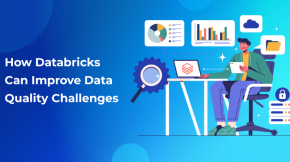Data Warehouse- The Ultimate Source to Discover Your Businesses Reality
There’s no doubt that the business world has become very competitive, and every company, no matter how small or big, generates huge amounts of data every day and looks for a reliable way to learn something useful from it.
Advanced methods that make it possible to use business intelligence in an organization’s structure to get good results have changed the function of data in a big way. But it’s hard to get the most out of the data because we don’t have the right tools and strategies to handle and organize such a large pool of data. In light of this, what should you do to manage the huge amounts of unstructured data and use it to its fullest potential to speed up business growth?
Here, the process of data warehousing comes in handy. It is a system that helps organizations, both small and large, make decisions by giving them real-time analytics. The right data warehousing solution will improve data analytics, help with reporting and analytics, and help create a number of use cases that will solve business problems.
But before we go into more detail about the idea, let’s look at what data warehousing is.
What is Data Warehouse?
Data warehouses are places where you store and analyze data to make good decisions.
From relational databases, transactional systems, and application system logs, among other places, data is often regularly put into a company’s data warehouse.
A “data warehouse” is a type of data management system that helps and supports business intelligence (BI), especially analytics.
Data warehouses usually have a lot of historical data and are only meant to be queried and analyzed.
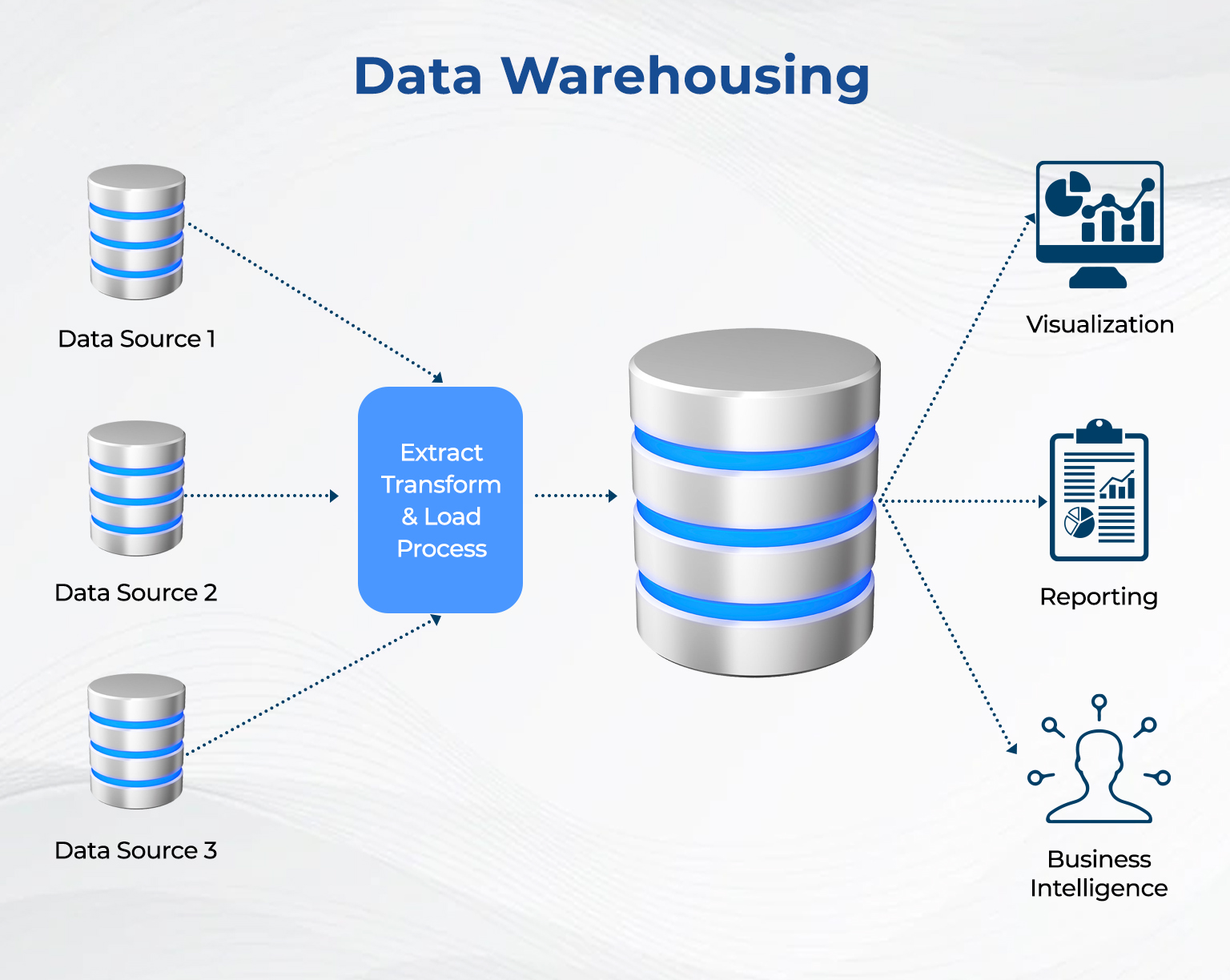
Commonly found in a standard data warehouse are the following components:
- A relational database for data management and archiving
- A method for data preparation through extraction, loading, and transformation (ELT)
- Data mining, presenting, and data analysis capabilities
- Tools for client analysis that visualize and convey data to users in the business world
- Other, more advanced analytical tools that use data science and artificial intelligence (AI) techniques, as well as graph and geographical aspects to enable more types of large-scale data analysis
How does Data Warehouse work?
The information comes from one or more data sources and is sent to a data warehouse, which stores it all in one place. A transactional system and several relational databases send data to a data warehouse.
The data warehouse works by collecting and putting together data into a complete database. After collecting the data, it is put into different tables based on what it is and how it is organized.
You can even use the data warehouse to store private company information, such as information about employees, their pay, and other things.
Data could be:
• Structured
• Semi-structured
• Unstructured
After changing, transforming, and ingesting the data, users can access it in the data warehouse using business intelligence tools, SQL clients, and spreadsheets. A data warehouse brings together information from many different sources into a single, comprehensive database.
You can look at your clients and predict future trends in a tough industry by using data from a data warehouse. When you know exactly what your customers want and what they expect from you, it is easier to treat them fairly and make them happy.
With the right data warehousing platform, you can always think ahead of your competitors regarding historical analysis, product development, pricing policies, predicting market changes, and customer happiness. Investing in a good data warehouse will help your business do better than the competition.
Difference between Data Lake and Data Warehouse?
A data lake is a massive repository of structured and unstructured data, and the purpose of this data has not been defined. A data warehouse is a repository of highly structured historical data which has been processed for a defined purpose.
Read more about Data Lake vs Data Warehouse
Types of Data Warehouse
There are mainly three types of data Warehouses:
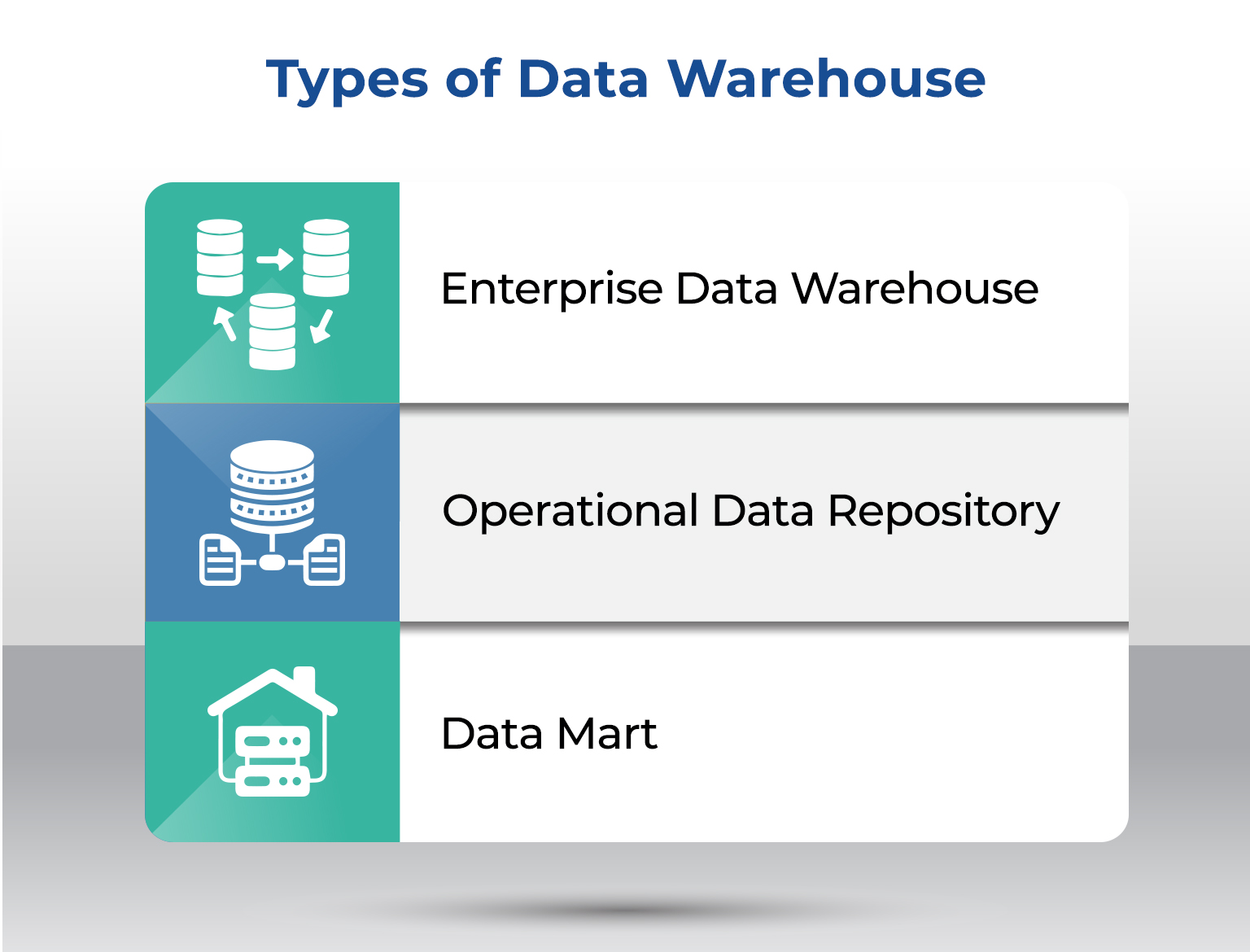
1. Data Warehouse for the Enterprise (EDW)
This is where you keep everything. It helps the business as a whole make decisions. It gives a safe way to gather and share information. It can also divide data into groups based on issues and control access based on those groups.
2. Operational Data Repository:
Operational data stores, or ODSs, are needed when OLTP or data warehouse systems can’t meet the reporting needs of an organization. The data warehouse at ODS is always being updated. Because of this, it is often chosen for routine tasks like keeping records on employees.
3. Data Mart:
A data mart is a part of a dw that is made to control a certain department, region, or business unit. Each division of a company has a central database or “data mart” where it stores its data. The ODS stores information from the data mart every so often. After the data has been used and stored, it is moved from the ODS to the EDW.
Components of Data Warehouse
There are mainly four components and these are:
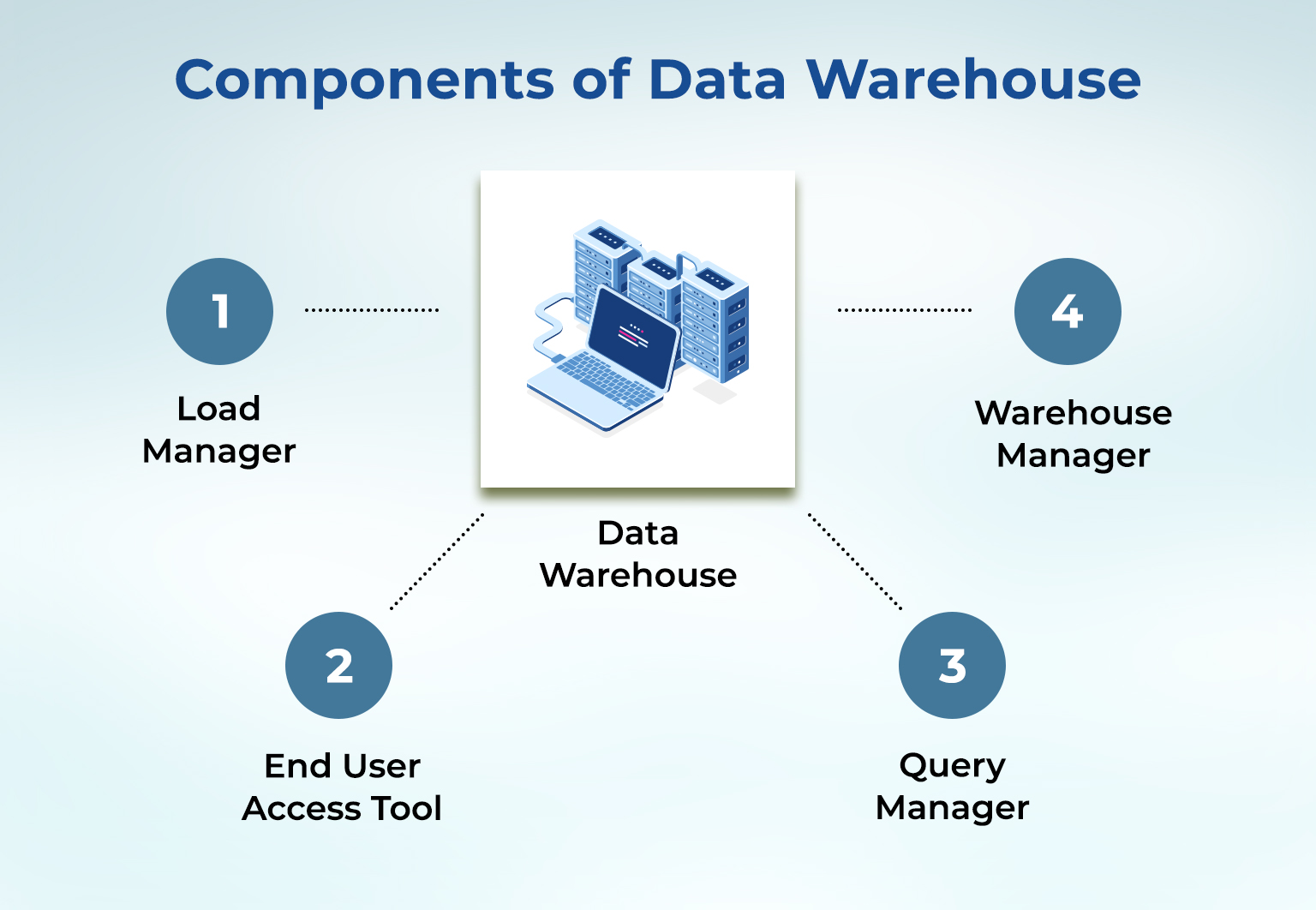
1. Load Manager
The load manager is another name for the front part. It does everything that needs to get data out of the warehouse and put it in. To get the data ready for the data warehouse, these processes change the data.
2. Warehouse Manager
The warehouse manager is in charge of all the tasks that have to do with managing the data in the warehouse. It does things like: analyze data to ensure its consistency, build an index and view, denormalize and generate aggregates, change source data and put it together, and back up and archive data.
3. Query Manager
The backend part is also called the Query Manager. It does everything to handle user requests. Part of how the data warehouse works are to plan how queries will be done by directly accessing the tables needed.
4. End User Access Tool
This is broken up into five parts, which are:
- Data Reporting
- Query Tools
- Tools for application development
- OLAP Tools and data mining Tools
- EIS tools
Data Warehouse Architecture
The data warehouse architecture is a method for outlining the overall structure of data exchange, analysis, and visualization that is present for end-client computing within the enterprise.
Why do you need Data Warehouse in your Organization?
There are many reasons why your company needs a Data Warehouse.
It is the “Single Truthful Source” for all the information in the company taking care of the following issues:
-Quality of data issues
-Reports with unstable data
-Inconsistent data
-Low Performance of Query
- Data warehouses make it easy to get important information from many different sources.
- You will get reliable information about many activities that involve more than one department. Both querying and reporting on the fly are possible.
- You can connect different data sources so that the production system doesn’t have to work as hard.
- Using a data warehouse speeds up the whole process of analyzing data and making reports.
- It’s easier to use for reporting and analysis now that it’s been reorganized and put together.
- Thanks to data warehouses, you can get important information from many different sources in one place. So, it saves time when getting information from different sources.
- Data warehouses store a large amount of data from the past. People can use this to look at different time periods and trends in order to predict the future.
- Data warehouses are always needed because queries are getting more complicated and you want to process them faster. Because data warehouses can quickly process denormalized data, transactional databases are designed to store data in a normalized form.
Top Applications of Data Warehousing
Let’s examine a few instances of businesses utilizing data warehouses as a necessary element of daily operations
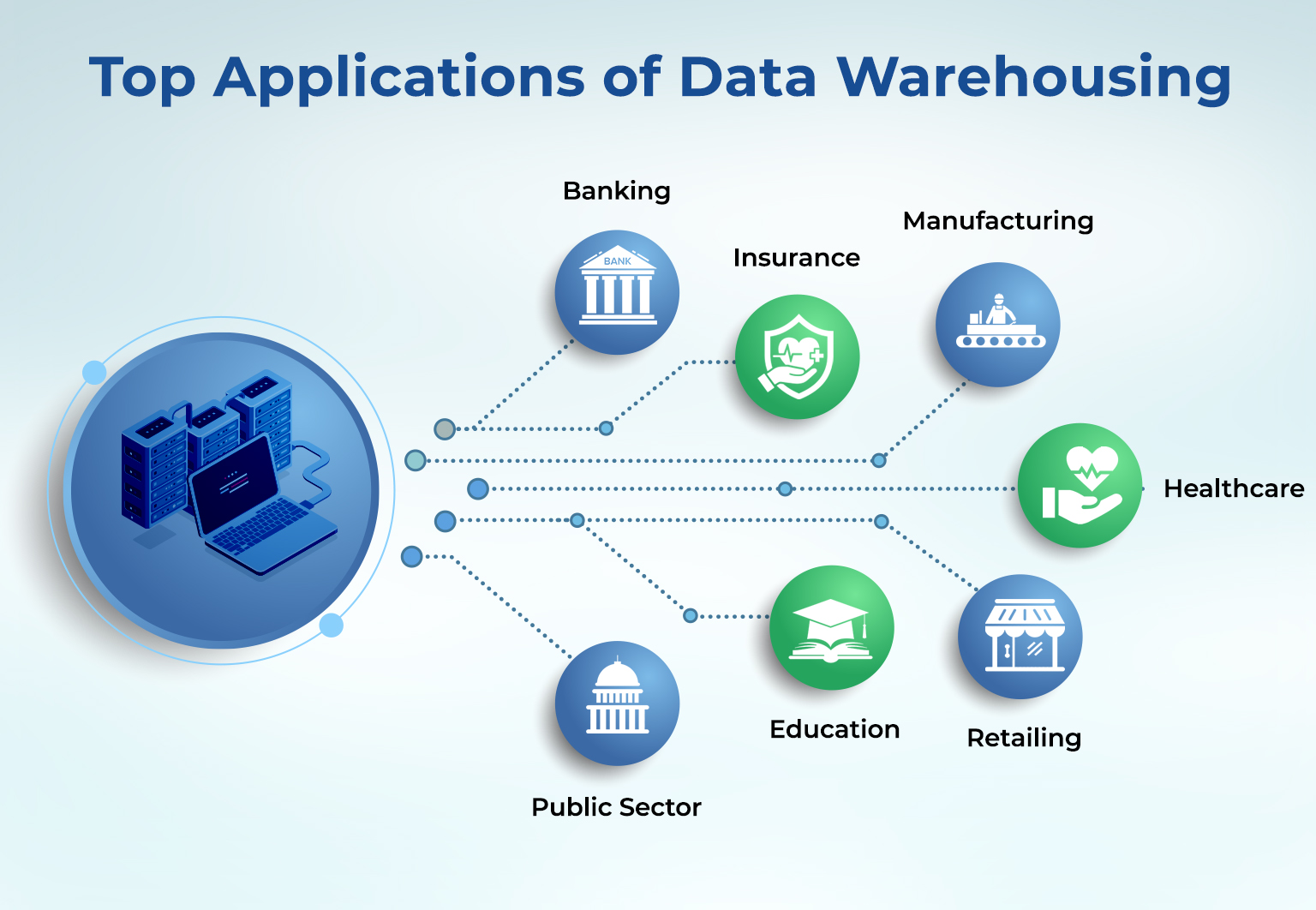
- Investment and insurance companies often use data warehouses to study the market, customers, and other data patterns. In some subsectors, like the Forex and stock markets, a single-point difference can cause everyone involved to lose a lot of money.
- Retail chains use data warehouses for marketing and distribution so they can keep track of their products, check their pricing strategies, and study what customers buy. For business intelligence and making predictions, they use models of data warehouses.
- On the other hand, healthcare organizations use data warehouse principles to make treatment reports, share data with insurance companies and departments of research and medicine, and write reports about how care was given. Business data warehouses are very important to healthcare systems because they need the most up-to-date information about treatments to save lives.
- The education industry requires data warehousing in order to fully understand its faculty and students. It gives educational institutions access to real-time data feeds so that they can make decisions that are smart and well-informed.
- The banking industry often uses it to keep track of desk resources well. Many banks also used it to study the market, evaluate the performance of their products and operations, and look at the market.
- Data warehouses are used by the government to gather information. It helps government workers keep track of and analyze tax information and health insurance records for each person.
- Manufacturing and distribution companies can consolidate all of their data, forecast market changes, examine current trends, identify potential growth areas, and make sound decisions.
- In the telecommunications business, a data warehouse is used to make decisions about distribution, product marketing, and sales.
How Beyond Key Data Warehouse can assist your business
Beyond Key helps you make your brand more visible in the digital market, which is very competitive. We give your business a powerful cloud-native SaaS platform that breaks down difficult data silos to give you insights that could help your business grow.
With Beyond Key’s data warehousing solution, you can take the first step toward becoming a fully data-driven organization by putting all of your data that is currently stuck in silos under one big roof.
With the help of our ETL data warehousing solution, you can collect data from multiple sources, organize it into a single, simple format, and store it in a data warehouse. This gives you a clearer picture of how your business works and the industry in which it competes, which helps you make better decisions.
Conclusion
Using an effective data warehouse, you can put all of your data on a cloud platform and organize it in the way you want. Structured data can be used by different parts of an organization to make decisions that will maximize return on investment.
The platform was made mainly to make it easier to do searches, make reports, and look at data on the fly. It also lets you pull large amounts of data from your business’s internal and external databases and turn it into useful information and insights that help you make better decisions.
A data warehouse is something that should be bought by any business that wants to make good business decisions.
If you want to set up a data warehouse in your company, you can schedule a demo at www.beyondkey.com.
FAQs
1. How effective must a data warehouse be in the modern era?
Many businesses need a data warehouse that is always up and running. After all, they need to be able to make decisions right away based on the analysis they already have.
In the end, a company’s choice of strategy is always affected by what it needs and, often, by how much money it has. The task, the user, and the application domain all play a role in real-time processing.
2. With our data warehouse solution, how many data sources can we integrate?
With data warehouse technologies, there are often many ways to connect different kinds of data. These include databases and other specialized ways to store information.
Depending on the solution you choose, you can combine a certain number of sources. But the following data sources can often be added to a data warehouse solution:
-Social media pages and websites
-Packages for accounting and ERP
-Recursive databases (PostgreSQL, MySQL, etc.)
-Databases without structures (NoSQL, MongoDB, etc.)
-Listings of document data (CSV, Google Sheets, etc.)
Using APIs and one-time authentication, you can build data bridges that work well and don’t need much maintenance.
3. What is meant by Cloud Data Warehouse?
A cloud data warehouse is a service that is run by a third party on a public cloud. Generally speaking, there are three types:
Under software-as-a-service (SaaS) models, the cloud provider takes care of everything.
Platform-as-a-Service (PaaS): This model lets the cloud provider control both the virtual software and hardware layers, except for subscriber-built apps.
Infrastructure-as-a-Service (IaaS) is a model in which the infrastructure is provided, but the subscriber is in charge of managing the virtual operating systems, databases, and middleware technologies.
Most vendors of on-premises data warehouse solutions offer at least a PaaS version, but the demand for full SaaS solutions is growing quickly.
4. What are the advantages of a Cloud Data Warehouse?
In recent years, most of the top data warehouse technology providers have favored on-premises solutions over cloud-based ones. This is primarily because of how much data is involved. Most providers are changing their focus at the moment, and cloud data warehouse solutions, especially hybrid ones, are growing a lot. It might look like cloud computing will make it so that on-premises infrastructure will soon no longer be needed.












